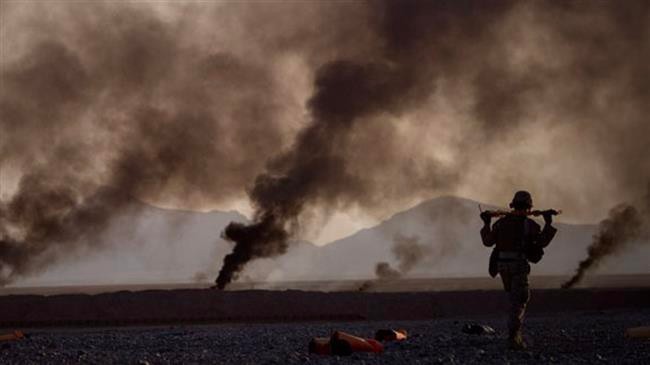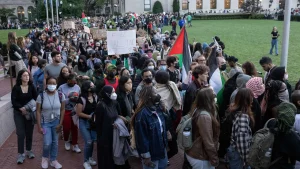In 2021, the U.S. Department of Defense issued its Climate Adaptation Plan, which has been lauded by corporate media as a supposedly serious mobilization against climate change. More recently, the U.S. Army has followed suit with its own Climate Strategy. More and more frequently, Democratic politicians are learning to frame the eternal imperative of an eternally expanding military budget in the language of “greening” the military. Similar language is used by Pentagon higher-ups, and even more frequently by those from the “industry” side of the military-industrial complex.
Make no mistake: the military is one of the worst polluters in the world and a huge contributor to climate change. The U.S. military owns enormous swaths of land and has a massive physical plant: by its own estimates, it outputs more carbon than all but 55 countries, and generates many other forms of pollution aside. In all, the United States maintains around 500 domestic bases and nearly 800 foreign ones, each an environmental black hole, unaccountable to any safety standards, reporting requirements, or community review and oversight. Beyond the carbon emitted by the daily operation of its millions of buildings and vehicles, the military has a long-term environmental footprint in the forms of toxic chemicals (leaked or dumped, often intentionally), ecologically disruptive changes to land-use, and direct repression of Indigenous land defenders and environmental justice movements.
So, without a doubt, the climate emergency demands a swift end to the polluting practices of the military. But what sort of changes will achieve this? In whose interest will a “sustainable transition” be effected? Allowing the military itself to propose and guide this transition will not, and cannot, lead to anything but a greenwashed imperialism. This would not represent even an incremental step towards climate action, because imperialism as a system of economic organization is deeply complicit in climate change. The military, as a leading “policeman” of the imperialist world order, can never take serious action to tear down the system it exists to protect.
The published plans for a supposed “green transition” of the military show precisely how a militaristic response, which treats climate change as a “national security” threat, lacks any concern for either the environment or humanity. The overriding concern is ensuring that the armed forces can continue to operate as usual. They focus on which foreign bases the military will have to relocate, what infrastructure needs to be made more resilient, what training is needed to deploy troops in new, harsher climates, and what conflicts it should prepare to repress as the Global South faces greater resource scarcity.
If these objectives seem to lack any connection with traditional goals of the climate movement, it is worth asking what interests they actually serve. The military has no interest in promoting sustainable resource use, protecting or restoring ecosystems, or ending extraction. A more fuel-efficient fleet of tanks, subs, warships, drones, and fighter jets may sound like incremental progress, but in the hands of the U.S. war machine, is no victory for the climate movement, nor for the billions of people around the world who suffer both the effects of a changing climate and the ravages of imperialism. A “more sustainable” border-industrial complex will still perpetrate the same violence against immigrants, even as the capitalist-driven climate crisis produces more environmental and economic refugees. Solar-powered prisons and fuel-efficient electric police cruisers still house the social-disciplinary tools to violently discipline the surplus population that capitalism relies on for its survival. Police, prisons, and borders deserve our condemnation on their own terms; but, apropos of environmental concerns, it’s important to stress that “green” fixes to these institutions represent deeply unserious distractions for the climate movement. To arrest the ravages of climate change, we must attack the underlying disease, of which militaries, police, prisons, and borders are symptoms. That disease is capitalism.
The Military’s Climate Priorities
Today’s militaries exist to enforce the land, borders, and resources of nation-states. For this reason alone, no bourgeois government’s military will ever allow the subversion of its “mission” to a broader goal such as climate mitigation, which is inherently internationalist and anti-extractive. Instead, as we see from the DoD’s own plans, a few token measures to reduce emissions will be paired with massive expansions to prepare for the “security threat” posed by a changing climate. The institutional logic of the U.S. capitalist state ensures that the military will only demand more money and resources for a militarized response to escalating climate chaos, doubling down on border violence, and making ever more aggressive moves to secure natural resources and transport corridors.
The logic of militarizing everything has uncanny parallels to the expansionary drive of capital in general. English economist William Jevons observed that when technology leads to increases in efficiency, resource use in that sector actually goes up, because capitalists see an opportunity for making more profit with the same outlay of capital: producing more for less. Similarly, when the military increases its planes’ fuel efficiency, for example, they are not obligated to run the same number of flights and save fuel; instead, with military superiority as their driving goal, efficiency gains are equally likely to incentivize more flights, to project more air-power with the same amount of fuel. The recent war in Ukraine reminds us just how eager the U.S. merchants of death are to find or invent new markets for their deadly wares. Imperialism is inherently unsustainable; it needs to expand. It will invoke the specters of authoritarianism and oriental aggression to justify ever-expanding weapons sales and militarized borders.
This logic leads to some extremely counter-intuitive “climate policies.” Take, for example, the Navy’s response to the potentially catastrophic melting of arctic sea ice. Rather than worry about the countries that will be swallowed by rising sea levels or ancient diseases that could be released from melting permafrost, their focus is on competition with Russia, as the melting Arctic opens potential new trade routes. Their proposed “solution” is to build more naval ships to cut through arctic sea ice to seize control of new trade routes before Russia can claim them. The buildup of military vessels, of course, will directly exacerbate the environmental crisis in the Arctic, but the military’s sole concern is how to leverage the situation in the interests of U.S. hegemony, even at the cost of wrecking one of the most vulnerable parts of the globe.
A Poisonous Presence Around the World
These priorities are completely disconnected from the costs of the crisis for the vast majority of people — those who don’t make up the capitalist class. Everywhere, capitalism extracts, exploits, and depletes natural resources, and these processes are mirrored by the violence that the military enacts against the people living there. This can be seen particularly clearly in the aggression that the U.S. military and other militarist institutions direct against frontline Indigenous water protectors and land defenders.
Recently, native Hawaiians have led the larger Oʻahu community in a fierce struggle to shut down Red Hill, a Navy base with enormous fuel storage facilities. Leaks from these tanks have poisoned a major source of drinking water on Oʻahu. The military has resisted the demands of the movement every step of the way, and even defied court orders to decommission the facility. Despite leaks as recently as April 2022, the military resisted and delayed shutting the facility down. As usual, pollution is not their concern; the tanks, even as they poisoned the water table, were an integral part of the U.S. strategic naval presence in Hawaiʻi, which in turn is key to protecting U.S. military power in the Pacific. The same imperatives that led the U.S. to annex Hawaiʻi in 1898 continues to visit destruction on the islands’ Indigenous people. Even now, as the Oʻahu community is forced to conserve water as a result of the Navy’s overuse, military infrastructure — including seven different military golf courses on Oʻahu — enjoys privileged access to scarce clean water.
Red Hill is just one example. U.S. military occupations throughout the Pacific have rejected and actively suppressed the struggles of Indigenous communities for decades. Similar dynamics can be found in Okinawa, Guam, and just about any territory occupied by the U.S. military throughout the Pacific. Okinawans, in particular, have endured rampant sexual harassment and assault from U.S. troops, and, just as in Oʻahu, the military presence on Okinawa has come with its own cases of the U.S. military poisoning drinking water.
Of course the dumping of toxic chemicals and rejection of people’s sovereignty extends far beyond the Pacific, and the worst consequences of the U.S. military presence throughout the world can be found in countries that the United States has directly gone to war with. Such countries include Vietnam, Cambodia, and Laos, which the United States blanketed in 20 million gallons of various herbicides during the Southeast Asia War, as well as Iraq where military waste was regularly burned in open air bonfires and munitions explosions have filled the air with especially high levels of heavy metals such as mercury, lead, and titanium.
There’s no way to know how many people around the world have been disabled and killed as a result of military contamination, not just in war zones, but also by the more routine impacts of U.S. military presence. In every case, the Pentagon goes to great lengths to cover up the consequences of its pollution, even when the victims are the military’s own troops and their families. Low estimates suggest that 400,000 people have died as a direct result of Agent Orange, with an additional two million suffering from cancers and other illnesses. This alone suggests that U.S. military pollution has likely killed millions of people, whose deaths will never be listed in official casualty estimates, and to whom the U.S. feels even less responsibility than its “recognized” victims. Because this kind of destruction is a side-effect of “official” military activities, they are not even up for discussion, appearing nowhere in the DoD’s climate adaptation plans. To the military top brass, these illnesses and deaths are unavoidable collateral damage to their core mission; they are incapable of recognizing that the military itself is an environmental hazard.
Though working class and oppressed communities occupied by the U.S. military abroad face the worst burdens of pollution, even communities within the United States are poisoned by the U.S. military. A recent report by the Department of Defense found that at least a dozen towns in the United States have had their residents poisoned as a result of neighboring military bases routinely using toxic substances for training exercises. While the U.S. military justifies its existence with the claim that they “protect American lives,” the fact is that the U.S. military’s existence is rooted in defending capital at great cost to human life. The international violence of the U.S. military’s sheer existence is perhaps best highlighted by the prominence of chemical pollution that the institution spreads everywhere from occupied island communities to countries in Southeast Asia and Middle East to the very heart of the empire.
Global Cops for Capital
The direct footprint of the military is vast and toxic, but the military is not just a contributor to climate change; it’s also an obstacle to climate action. To limit an analysis of the military’s environmental ills to its direct emissions, as with any other polluter, overlooks its function in maintaining the imperialist order. Yes, we should trace, tabulate, and condemn the emissions from the military’s tanks, planes, and ships. We should document and resist the destruction wreaked by the supply chains that construct and supply the U.S. global presence. We must protest and prevent the toxic chemical pollution that inevitably accompanies U.S. occupations. But, it’s crucial to go further: to recognize that the military is the enforcement mechanism for the fossil capital regime which is driving the climate crisis. The various branches of the American military ensure the “security” of global extractive flows of raw materials which are the source of capitalist profits. They enforce the colonial debt obligations and border regimes that ensure cheap pools of labor in semi-colonial nations; they are the physical manifestation of the U.S. government’s political role as protector of the fossil-extractivist sector of global capital. When the U.S. speaks of “security,” this is nothing more than a euphemism for maintaining the deeply unjust social relations that favor the interests of capital. “Security” in this sense is deeply antithetical to security for the poor and working people of the world, who are threatened by the environmental harms of capitalism and climate change, often by the repressive boot of the U.S. military itself.
A movement for climate justice which hopes to tackle the problem of environmental inequality at scale must challenge the fallacy of green militarism. The Pentagon has already begun to use the language of environmental justice to co-opt the demands of the movement into energy for ballooning its budget, even as, this year, the 2023 allotment for climate-related expenses make up less than half of one percent. As the consequences of climate breakdown accumulate and compound, the military will cite the unfolding chaos as a “threat multiplier” from which they alone can protect Americans. However, they’ll also claim that this is a new kind of threat, one that demands all sorts of new equipment, infrastructure, and an ever-multiplying array of agencies, units, and subcontracts. The logic of military expansion is unfalsifiable. As long as “security,” as defined by the military, is the basic concern, climate change is understood as a tactical challenge to U.S. hegemony, not an existential threat to humanity as a whole. This is basically acknowledged by the military and its apologists: “Electrification for the military has to be something that’s operationally valuable, rather than being strictly for the purposes of climate change,” admits the Hudson Institute’s Bryan Clark. Environmentalists should take this seriously; the military won’t meaningfully “green” itself. It can’t be recycled; it must be scrapped.
The Many Faces of Climate Militarism
The consequences of militarism adapting to the climate crisis have implications well beyond the purview of the Department of Defense. Much like the military, police departments and border patrols maintain and enforce the interests of capital, at the expense of the global working class and oppressed communities. For this reason, an environmental definition of “militarism” must extend beyond the branches of the military to include militarized police forces and border patrols. In fact, the recent freelancing of the National Guard to keep out migrants from the Global South — including many climate refugees — and the role that the Pentagon’s 1033 program plays in supplying police departments with military-grade equipment, demonstrates how militarized forces merge and empower one another. As the climate crisis is increasingly redefined as a “national security threat,” we can expect a militarized response to increasingly call upon the armed forces that oppress workers abroad, to merge them with those that oppress workers in and around the borders of the United States.
The most brazen domestic examples of state violence against the climate movement can be found in the treatment of Indigenous people who organize to protect their lands, like the brutal police responses to Indigenous-led pipeline protests. The #NoDAPL movement and Stop Line 3 movement, in particular, faced intense police repression, in the form of physical violence and surveillance of activists. In a grotesque irony, police have actually begun using the climate crisis as an excuse to obtain the militarized equipment that they use to oppress communities fighting to save the planet. As more people realize that climate justice can only be obtained by challenging the structures of extractive capitalism, the movement will come more into conflict with the police, whose job is to maintain these structures.
In urban communities, too, the police have long been known as an occupying, militarized presence, and an active impediment to justice, environmental and otherwise. America’s history of racial segregation has built racialized environmental injustice into the very physical geography of cities, from the lack of greenspace and waterfront access, to the disproportionate siteing of toxic industry, highways, and waste facilities near concentrations of poverty. The police play a key role in enforcing this inequality, meeting every self-organized attempt at bettering the urban environment — from quashing a long-running outdoor community gym in Harlem to evicting mothers in California who occupy foreclosed houses — with violence and repression. The project of abolishing the police is not just a struggle against the terror they impose on Black communities; it’s also integral to the climate movement, because racial justice cannot be separated from environmental justice. Moving power from police to the working people of a community is a necessary step in securing their ability to fight for a sustainable future.
Prisons are yet another important conjuncture of environmental and social struggle, particularly in the United States. For decades, abolitionists have pointed to the burgeoning system of private and public prisons as a tool for containing “surplus” populations, for dividing and suppressing communities or movements that present challenges or alternatives to neoliberal normality. They are tools of economic and social discipline, and not just for those behind their walls and the communities they are torn from. As physically sited structures, they also impose economic and environmental pressures on the towns in which they are located. As major local employers, prisons pit the economic interests of their workers against the rights of the incarcerated, even as they drive away other economic opportunities in the area just by being there. As heavily fortified human cages which require round-the-clock intensive resource use, prisons produce enormous environmental harms, justified to local populations as a necessary trade-off for jobs.
Similar to militaries, environmental costs are incidental to the “mission” of prisons, and can thus only be mitigated, never reversed, without a fundamental challenge to the logic of incarceration. However, even as capitalism has created this horrible carceral edifice, it has also created the conditions for a powerful site of struggle, with a deep organic connection between economic, social, and environmental justice. Environmentalists who struggle against toxic infrastructure must recognize the necessity of connecting their fights with abolitionist organizing. When prisons are sited in poor communities, the choice is presented as a devil’s bargain: accept the prison for the jobs it will create, at the expense of the health of the community and the environment, not to mention the impact on those to be incarcerated therein. Overcoming this unnecessary evil and building a movement for tearing down prison walls and practicing restorative justice, both social and environmental, is a fundamental task of the environmental movement, if it is to build the power of the organized working class.
Domestic racial oppression is mirrored by the increasingly militarized U.S. borders, and the growing anti-immigrant sentiment against racialized “others.” As the climate crisis worsens, so too will mass migration from the Global South. Already there is an increase of immigration from Central American countries, and many of the migrants are climate refugees. U.S. industry bears responsibility for devastating the environments of Central America and underdeveloping these countries’ ability to respond to climate disaster; yet, U.S. policy towards migrants is incredibly violent, subjecting them to advanced surveillance methods developed by apartheid Israel, and to draconian detention policies, often as a prelude to deportation.
Though the bulk of border enforcement is enacted by the Department of Homeland Security, the Pentagon is playing a significant role in training border enforcement through Operation Vigilant Sentry. This initiative by the Pentagon increases cooperation with armed forces and police forces to more effectively intercept migrants from the Caribbean, another region degraded and undeveloped by U.S. industry.
The militarized response to climate refugees legitimizes a nationalist response to the climate crisis — an easy path towards eco-fascism or climate apartheid. Hardened nationalism in response to the climate crisis conveniently and deliberately erases the role that U.S. imperialism has played in creating the conditions for forced displacement of populations from the Global South, and must be opposed on these grounds; we cannot ignore the “environmental debt” accrued from centuries of extractive and polluting practices. And, ultimately, a nationalist response will be practically inadequate, since the wealthy countries of the Global North simply cannot bubble themselves off from climate disaster. This points to the necessity of a climate movement that is consciously internationalist and anti-nationalist, organized among the working and oppressed people of the world to oppose capitalist climate criminals wherever they exist.
Towards an anti-imperialist climate movement
We should be perfectly clear: there are no “green” militaries, and no green forms of militarism. The goals of nationalist and imperialist militaries, and of domestic security forces like police departments, border regimes, and prisons, are fundamentally opposed to the internationalist project of fighting climate change. Their security is not our security. Wherever the climate movement uncritically allows the Pentagon or a police department to co-opt the language of sustainability, it subordinates itself to the nationalist and bourgeois goals of these institutions and weakens itself for the fights to come. The climate movement needs to reach across—and to dismantle—the very barriers and borders that militaries are meant to enforce. Therefore, the fight for climate justice is inseparable from the fight for racial justice in the United States, or for the rights of migrants at the borders. Climate justice is inseparable from the struggles for economic and political self-determination in semi-colonial countries, whose resources and labor fuel the engines of global capitalism. And, contrary to those who insist that the issue of climate change should be prioritized above all struggles, we recognize the very interconnectedness of these struggles as the key to uniting them in a movement capable of challenging the oppression, misery, and environmental degradation inherent to capitalism.
The U.S. Left has so far failed to pose a powerful, working-class challenge to capitalist-driven climate change, in large part because it has not fully connected climate struggles to a broader fight against imperialism and its agents. Ceding rhetorical and ideological ground to the forces of militarism obscures and absolves their role in driving the crisis. When the climate movement allows the military to posture as a progressive force in the fight against climate change, it shores up the very system that needs to be replaced.
A climate movement that aims to win a sustainable future must take up the task of uniting with movements of the oppressed. Environmentalists must coordinate their struggle in solidarity with abolition and immigrants’ rights activists. These movements together could build a fighting force which can elevate the demand to defund the Pentagon as an essential part of environmental sustainability. Demands to close military bases, to abolish the police, to open the borders, and to welcome climate refugees are not auxiliary or “wishlist” demands; they are strategically central to the goals of the climate movement. The work of co-opting green language for the purposes of imperialism has already begun, so the climate movement must urgently take up the task of building a class-independent, internationalist force, stubbornly opposed to militarization, nationalism and carcerality, for an environmental justice that benefits working and oppressed people around the world.










